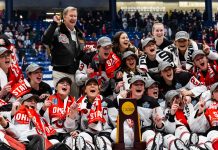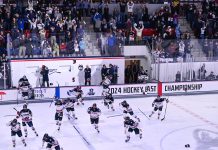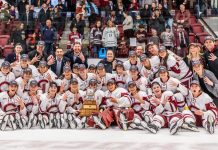With a strangling defense and an offense with the potential to put up big numbers, the 2003-04 Cornell Big Red looked to be one of the teams to beat in the ECAC.
Decimated by injuries throughout the season, most notably to offensive threat Ryan Vesce, the team found itself clawing its way back from the middle of the pack by the end of the season before receiving an early ticket home from a hot Clarkson team in the playoffs.
“Naturally,” said head coach Mike Schafer, “we were really disappointed with how our season ended. It was something that stuck in all of our minds. We’re very anxious to get back at it. A lot of things have to go right this year where a lot of things went wrong last year.”
Despite the quarterfinal loss to the Golden Knights, Cornell’s late surge of stingy victories, including seven of its final eight regular-season contests, reminded the rest of the league of the Big Red’s potential.
The youthful squad, featuring 16 underclassmen and nine freshmen, began piecing together the ingredients for a potentially overpowering future. Forwards such as Byron Bitz, who finished fourth on the team with 21 points, and Mitch Carefoot, whose six goals led all first years, found their offensive footing just as the season was coming to a close.
“I look at our sophomore class as a group of guys who really started to score and pick it up at the end of the year,” said Schafer. “To pick just one player, I’d probably end up wrong. I’d love to have one guy break out and score 15 to 20 goals, but it would be even better if a few guys could put up 10 to 15.”
Cornell filled its perennial role as defensive powerhouse last year, as the team allowed less than two goals a game while rookie goaltender David McKee posted a .920 save percentage in the wake of departed Hobey Baker finalist Dave LeNeveu.
The major surprise of last year, however, came less in how many losses the Big Red suffered, but where they suffered them. After going undefeated at Lynah Rink en route to a Frozen Four appearance in 2003, Cornell finished only 7-7-5 in Ithaca last season.
“You have to approach each year differently,” explained Schafer. “Last year, with a young team, we did poorly at home for some reason, but our record on the road was really solid. I compare it to our team three years ago, which didn’t score much but always kept its goals against average down.”
Once again, Cornell hopes to fill holes with one of the strongest recruiting classes in the league. At the top of this tall and physically daunting list is 6-foot-2 Ray Sawada, a 195-pound forward from Richmond, B.C.
“Sawada, who was selected in the second round of this year’s draft by Dallas, could be a dynamic player,” said Schafer. “He has the physical dimensions and offensive skills to be a presence on the line and move the puck as well.”
The rookie, and the rest of his teammates, hit the ice for an exhibition game against McGill on October 22 before opening the season against Army one week later.


